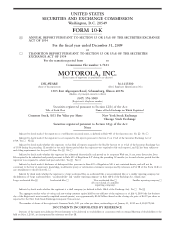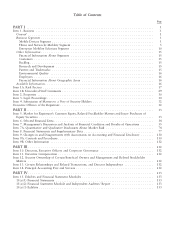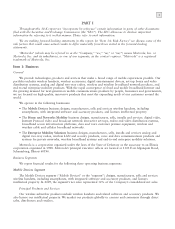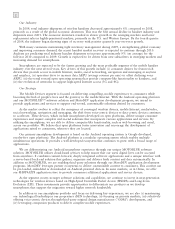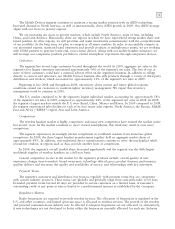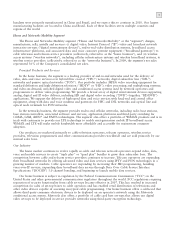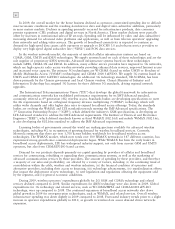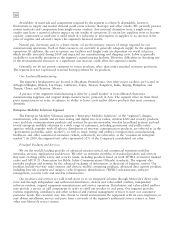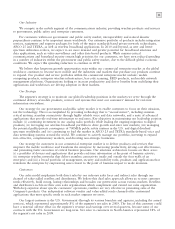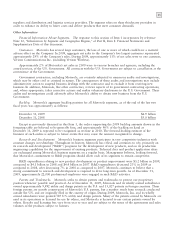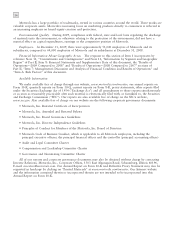Motorola 2009 Annual Report Download - page 17
Download and view the complete annual report
Please find page 17 of the 2009 Motorola annual report below. You can navigate through the pages in the report by either clicking on the pages listed below, or by using the keyword search tool below to find specific information within the annual report.
9
The FCC continues to examine ways to promote commercial availability of retail video CPE devices that can
deliver Multichannel Video Programming Distributor (MVPD) content to consumers. While the FCC has not
formally proposed any new regulatory mandates in this area, changes to the existing framework could impact our
set-top box business.
The U.S. leads the world in spectrum deregulation, allowing new wireless communications technologies to be
developed and offered for sale. Examples include wireless local area network systems, such as WiFi, and wide
area network systems, such as WiMAX and LTE. Other countries have also deregulated portions of their
available spectrum to allow deployment of these and other technologies. Deregulation may introduce new
competition and new opportunities for Motorola and our customers.
As more fully described under ‘‘Enterprise Mobility Solutions—Regulatory Matters,’’ as television
transmission and reception technology transitions from analog to more efficient digital modes, various countries
around the world are examining, and in some cases already pursuing, the redevelopment of portions of the
television spectrum. Certain segments of the spectrum that have historically been utilized for analog television
have now been designated to support new commercial communications systems and, therefore, are expected to
generate new business opportunities for Motorola in wireless and video technologies. In the U.S., the FCC
conducted an auction of spectrum for the 700 MHz band reclaimed by the government in June 2009. License for
this spectrum may be used for flexible fixed, mobile and broadcast applications. Although the auction winners
will determine the best utilization of the acquired spectrum, both LTE and WiMAX are candidates for technology
selection. In addition, a contiguous portion of this spectrum has generated interest for mobile TV applications.
Backlog
The segment’s backlog was $2.1 billion at December 31, 2009, compared to $2.3 billion at December 31,
2008. The 2009 order backlog is believed to be generally firm and 100% of that amount is expected to be
recognized as revenue during 2010. The forward-looking estimate of the firmness of such orders is subject to
future events that may cause the amount recognized to change.
Intellectual Property Matters
Patent protection is extremely important to the segment’s operations. The segment has an extensive portfolio
of patents relating to its products, systems, technologies and manufacturing processes.
The segment seeks to build upon our core enabling technologies, such as digital compression, encryption and
conditional access systems, and wireless air-interface technology in order to lead worldwide growth in the market
for wired and wireless communications networks. Our policy is to protect our proprietary position by, among
other methods, filing U.S. and foreign patent applications to protect technology and improvements that we
consider important to the development of our business. We also rely on our proprietary knowledge and ongoing
technological innovation to develop and maintain our competitive position and will periodically seek to include
our proprietary technologies in certain patent pools that support the implementation of standards. We are a
founder of MPEG LA, the patent licensing authority established to foster broad deployment of
MPEG-2-compliant systems, and we have recently joined the MPEG4-Visual patent pool as a licensor. In addition,
we have licensed our digital conditional access technology, DigiCipher II, to other equipment suppliers and
continue our joint ventures with Comcast for development and licensing of conditional access technology.
We also enter into other license agreements, both as licensor and licensee, covering certain products and
processes with various companies. These license agreements require the payment of certain royalties that are not
expected to be material to the segment’s financial results. Royalty and licensing fees vary from year to year and
are subject to the terms of the agreements and sales volumes of the products subject to licenses. The protection of
these licenses is also important to the segment’s operations. For additional information relating to patents,
trademarks and research and development activities with respect to this segment, see the discussion under ‘‘Other
Information’’.
Inventory, Raw Materials, Right of Return and Seasonality
The segment’s practice is to carry reasonable amounts of inventory in order to meet customer delivery
requirements in a manner consistent with industry standards. At the end of 2009, the segment had lower
inventory balances than at the end of 2008, primarily due to lower sales levels as well as manufacturing strategies
to reduce inventory levels.


